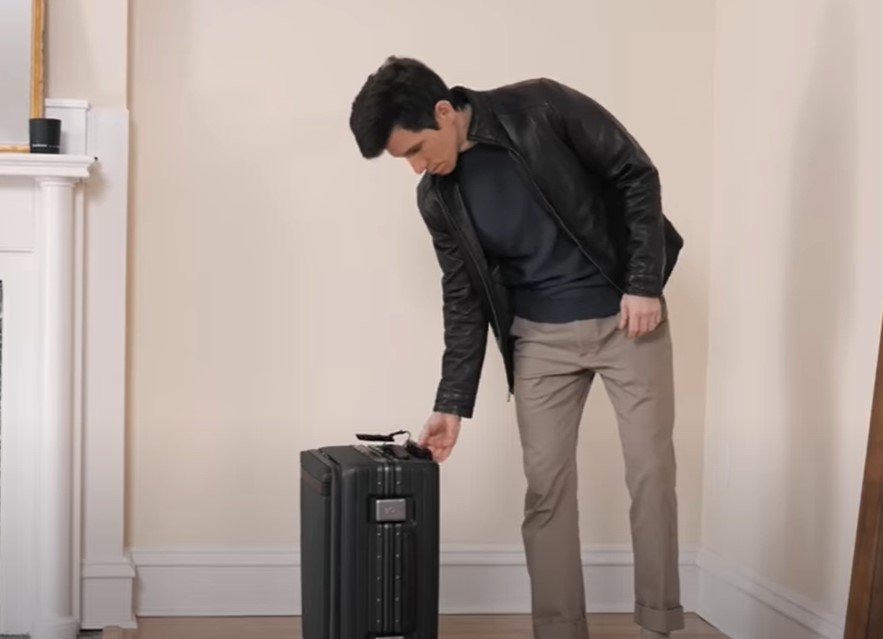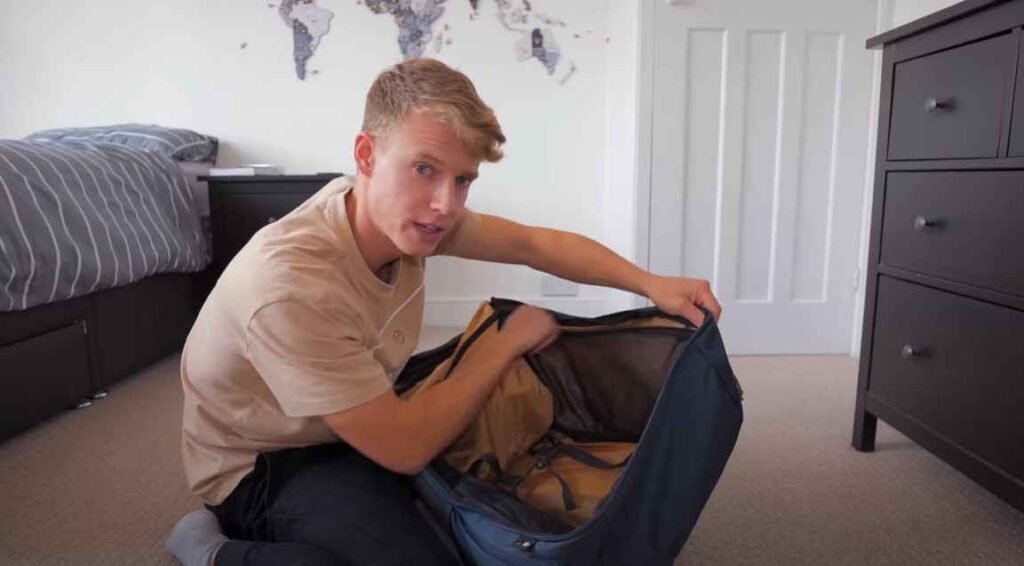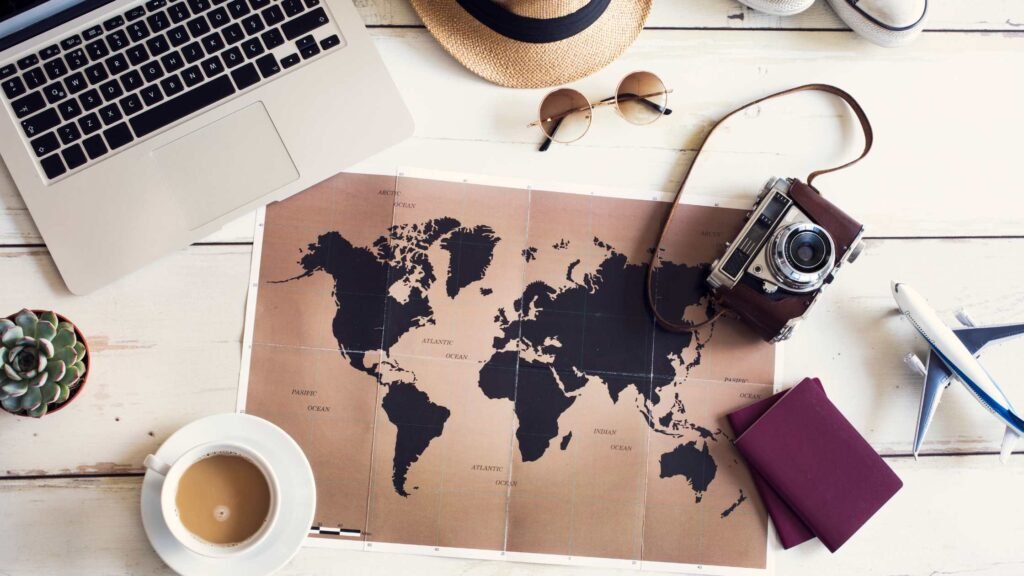You should start packing for a trip at least a week before your departure. This allows time to organize essentials and handle unforeseen tasks.
Beginning your packing process a week in advance strikes the perfect balance between preparedness and efficiency. Embarking on this task too early can lead to overpacking and stress while leaving it too late might result in forgetting vital items or encountering last-minute hitches.
Keep in mind that the type of trip also influences your packing timeline; a weekend getaway requires less prep time than an international journey. Streamline your prep work by creating a packing list tailored to your destination’s climate and activities planned. Let’s deliberate about “When Should You Start Packing for a Trip?”
Regular travelers might find it helpful to maintain a ready-to-go travel essentials kit. By starting to pack early, you ensure a smooth start to your adventure, with ample time to double-check essentials and buy any last-minute necessities.
Table of Contents
Toggle- Introduction To Trip Planning And Packing
- Interpretation Your Trip Itinerary
- Types Of Trips And Packing Dynamics
- The Early Bird Approach To Packing
- Last-minute Packing: Risks And Tips
- Checklist Creation And Usage
- Packing Essentials And Non-essentials
- Specialized Packing For Adventure Trips
- Family Trips: Coordinating Packing For Multiple People
- Advanced Packing Techniques And Hacks
- Final Preparations And Pre-departure Check
- Frequently Asked Questions On When Should You Start Packing For A Trip
- Conclusion
Introduction To Trip Planning And Packing

Welcome to the world of trip planning and packing! Packing for a trip is much like a puzzle. You must fit each piece correctly for a successful journey.
Planning a trip excites and sometimes overwhelms. What goes into the luggage can make or break a vacation. Let’s master the art of timely packing.
Importance Of Timely Packing
Packing at the right time is crucial. It helps avoid forgetting essentials and reduces stress. Timely packing allows for careful selection. You bring what you need and leave behind what you don’t.
- Less stress – More time to pack means less rush.
- No forgetting items – Time to double-check your list.
- Smart choices – Decide what’s a must and what’s not.
Factors That Influence Packing Schedule
Several factors play into when you should start packing. Here are a few:
- Destination – Colder places need bigger clothes.
- Duration – Longer trips need more things.
- Activities – Hiking or swimming; gear differs.
- Transport – Checked bags or carry-on? Space matters.
Interpretation Your Trip Itinerary
Packing for a trip often stumps even the savviest of travelers. Knowing when to begin can set your journey off to a smooth start. It all begins with a deep dive into your getaway details.
Analyzing The Destination And Duration
Different destinations and trip lengths require unique packing strategies. A weekend beach vacation demands less than a two-week mountain trek. List your activities and notes from the itinerary. This shapes your packing list.
For example:
| Destination | Duration | Activity Type |
|---|---|---|
| Tropical Island | 3 Days | Sunbathing, Swimming |
| European City | 1 Week | Sightseeing, Dining |
| Mountain Retreat | 2 Weeks | Hiking, Camping |
Short trips mean fewer items; long journeys need more planning.
Considering Season And Weather Patterns
Seasons greatly affect your packing. Research the expected weather patterns for your destination. It’s important to pack accordingly to stay comfortable.
- Winter: Heavy coats, boots, warm accessories
- Spring: Layering options, rain gear, light jackets
- Summer: Swimwear, hats, light clothing
- Fall: Warm layers, versatile footwear, knitwear
Check the forecast a week before your trip. Make final adjustments to suit sudden weather changes.
Types Of Trips And Packing Dynamics
Comprehension of the Types of Trips and Packing Dynamics transforms trip preparation into an art form. Consider this: not all journeys require the same packing strategy. The destination, purpose of travel, and duration strongly influence what and how to pack. Ready to delve into the world of packing wisely?
Let’s explore how different trips call for distinct packing approaches.
Leisure Vs. Business Trip Packing
Leisure and business trips have unique needs. For leisure travel, think versatile and comfortable. Pack clothes that can mix and match, thus creating more outfits with fewer items. Remember to include your essentials: swimwear, reading material, and a camera.
- Casual shirts and pants: for daytime exploration
- Elegant dining outfits: for the nightlife
- Comfortable shoes: to keep you moving
- Essentials (sunscreen, hats, sunglasses): to protect and enjoy
Business trips require a sharper look. Consider the nature of meetings and conferences. Include professional attire and a reliable laptop or tablet. Do not forget the power adapters and chargers.
- Suits or formal wear: For that professional edge
- Document organizer: To keep work in order
- Tech accessories: For seamless presentations
- Travel-size toiletries: To stay fresh
Domestic Vs. International Travel Considerations
Domestic travel often means lighter packing. You’re likely familiar with the climate and customs. Essentials might include:
- Weather-appropriate attire
- An ID and credit cards
- Snacks for the journey
- Entertainment options
International trips demand more preparation. Passports, travel visas, foreign currency, and language guides top the list. Consider:
| Travel Essentials | Description |
|---|---|
| Adapters for Different Outlets | Carry adapters to ensure compatibility with local power outlets. |
| Travel Insurance Documents | Keep all necessary travel insurance documents accessible and secure. |
| Cultural Research | Research to understand and respect local customs and traditions. |
| Health Precautions | Take necessary health precautions, including vaccines and medications. |
Different countries can mean drastic weather changes. Pack clothing that suits the destination’s climate. Allow space for souvenirs and additional purchases. Keep travel comfort, security, and adaptability in mind while packing for international adventures.
The Early Bird Approach To Packing

Are you eager to ensure a smooth start to your trip? Let’s talk about the smart habit of packing early, known as The Early Bird Approach to Packing. This method eases travel stress and avoids last-minute mishaps. Get ready to become a packing pro!
Advantages Of Packing Weeks In Advance
Packing weeks ahead comes with multiple benefits:
- Say goodbye to stress: Avoid the rush and pack in peace.
- Better organization: Give every item a thoughtful spot.
- Time to adjust: Change your mind? Swap items easily.
- Early error detection: Spot missing or damaged gear in time.
- Weather ready: Check forecasts and adjust your wardrobe.
Packing Strategies For The Proactive Traveler
Packing early can become even more effective with these strategies:
- Checklists are key: List everything to ensure nothing’s forgotten.
- Pack by category: Group items like clothes, gadgets, and toiletries.
- Roll or fold: Save space. Roll casual clothes, fold others.
- Essentials first: Prioritize must-haves over “just in case” items.
Use packing cubes for extra organization. They keep clothes neat and accessible.
| Weeks Before Trip | Task |
|---|---|
| 4-6 Weeks | Create a packing list and start buying travel essentials. |
| 2-4 Weeks | Begin to pack, check the weather, and arrange outfits. |
| 1-2 Weeks | Finalize packing, and double-check everything. |
By embracing the Early Bird Approach, your pre-trip experience can be as calm and enjoyable as your actual holiday. Start packing now and thank yourself later!
Last-minute Packing: Risks And Tips
Packing for a trip often gets left to the last minute. This habit can lead to forgotten items and unnecessary stress. Grasping the risks and arming yourself with tips for efficient packing can transform the experience. Read on to find out how to master the art of last-minute packing.
Common Pitfalls Of Packing At The Eleventh Hour
Last-minute packing is a risky game. People often make mistakes that can impact their trips. Here are some common pitfalls:
- Forgetting essentials: Chargers, toothbrushes, or travel documents may slip your mind.
- Overpacking: You might pack things you don’t need, making your luggage heavy.
- Ignoring weather: Neglect to check the forecast and pack accordingly.
- Stress: Rushing can cause anxiety and start your trip on the wrong foot.
Efficient Last-minute Packing Techniques
To avoid these pitfalls, here are some techniques for efficient last-minute packing:
- Start with a list: Quickly jot down essentials to ensure nothing is missed.
- Choose versatile clothing: Opt for pieces you can mix and match.
- Use packing cubes: They help organize and compress items, saving space.
- Check the weather: Do a quick search to pack appropriate clothing.
- Have a toiletry bag ready: Keep one stocked with travel-sized items.
Checklist Creation And Usage
Preparing for a trip can sometimes feel overwhelming. A well-structured checklist can transform this chaotic experience into a smooth journey towards your destination. Creating a packing list ensures nothing gets left behind. Let’s Jump into how to create and use these lists to your advantage.
How To Make An Effective Packing List
Creating a packing list is like drawing a map for your travels. Start with categories such as clothes, gadgets, toiletries, and documents. Under each, jot down essentials. For clothes, think of the weather and activities planned. Charge gadgets and gather chargers. Don’t forget travel-sized toiletries and important documents like passports.
Here’s a quick breakdown:
| Category | Items |
|---|---|
| Clothes | According to the weather and itinerary |
| Gadgets | Phone, camera, chargers |
| Toiletries | Travel sizes, personal care items |
| Documents | Passports, visas, insurance |
Utilizing Checklists To Organize Packing Process
With your list ready, the packing process becomes straightforward. Check off items as they go into your bag. This prevents clutter and redundancy. Keep your list on hand for repacking later. This method ensures both efficiency and peace of mind.
- Start with essentials: Always pack these first.
- Double-check: Use the list to review before departure.
- Update when necessary: If you missed something, add it for next time.
Packing Essentials And Non-essentials
Knowing what to pack can seem like a puzzle, but it’s simple.
Separate your items into two categories – essentials and non-essentials.
Identifying Must-have Items For Any Trip
Prioritizing must-have items will make packing easier.
- Travel documents (passport, tickets)
- Medications
- Clothing appropriate for your destination
- Phone charger and power bank
- Toiletries (in travel-size containers)
- Important electronics (camera, e-reader)
- Any necessary travel aids (maps, guidebooks)
Determining What To Leave Behind
Avoid overpacking by determining what to leave at home.
| Item | Reason to Leave Behind |
|---|---|
| Bulky Towels | Hotels often provide them |
| Many books | Choose an e-reader or a single book |
| Multiple gadgets | Stick to multifunctional devices |
| Excessive shoes | Limit to two pairs: one casual, one formal |
Remember, lighter luggage makes for easier travel.
Specialized Packing For Adventure Trips

Adventure trips demand meticulous preparation. Unlike a leisurely vacation, specific gear and clothing are essential for these excursions. Knowing what to pack and when to pack can make a difference in your travel experience. This section will navigate you through the intricacies of specialized packing for your adrenaline-fueled journeys.
Gear And Clothing Specifics For Outdoor Expeditions
Timing The Packing For Remote Or Unusual Destinations
Family Trips: Coordinating Packing For Multiple People
Family Trips: Coordinating Packing for Multiple People can seem like a juggling act, with more balls in the air than one can comfortably manage. Throw kids into the mix, and the potential for chaos multiplies. But fear not! With a strategy in place, packing for your family adventure can transform into an enjoyable activity, teaching your kids valuable life skills and ensuring everything needed finds its way into your suitcases.
Making It A Family Affair: Engaging Kids In Packing
Turn packing into a fun game for your children. Turn it into a mini-adventure! Start with a list of items for each child and challenge them to find and pack their belongings. Use illustrations or pictures for younger kids.
Encourage them to make decisions—let them choose between items where possible. Praise their choices and pack the items they’re most excited about first. To make sure no essential gets left behind, you might want to double-check their packing once they’re done.
- Prepare a personalized checklist for each child with easy-to-understand pictures or symbols.
- Assign a distinct color for each family member’s luggage for quick identification.
- Let kids pick their favorite clothes and toys within reason.
- Reward cooperation with a small treat or extra playtime.
Synchronization Of Luggage And Responsibility Division
When each family member knows what they’re responsible for, packing becomes streamlined. Break down tasks based on age and ability. Older children might handle their packing, while younger ones need guidance.
Create a central packing station in your home. Here, everyone’s items come together, ready for the final pack. Ensure that each bag doesn’t exceed weight limits and that all essentials are accessible.
| Family Member | Responsibility | Luggage Color |
|---|---|---|
| Parent(s) | Travel documents, itinerary, valuables | Black/Gray |
| Teenagers | Their clothing, gadgets, books | Blue/Red |
| Younger Children | Favorite toy, blanket, snack | Green/Yellow |
In summary, engage each child in the packing process for family trips. Synchronize luggage and responsibilities. Make the process transparent, and encourage ownership. With practice, your family trip preparations will not only become efficient but also an exciting prelude to the adventure ahead!
Advanced Packing Techniques And Hacks
Packing for a trip can feel like a puzzle. One you can solve with a bit of know-how. These advanced techniques and hacks will make packing a breeze. Let’s dig into how you can save space and time before your next adventure.
Space-saving Methods And Organization Hacks
- Roll, don’t fold – Rolling clothes instead of folding them compresses the garments and creates more room.
- Use vacuum bags – Vacuum-sealed bags can reduce the volume of your clothes by up to 80%.
- Fill dead space – Pack socks and underwear inside your shoes to maximize every inch of your suitcase.
- Categorize with packing cubes – Packing cubes help organize and compress clothes even further.
- Layer with purpose – Place heavier items at the bottom of your luggage for stability.
Innovative Packing Solutions And Gear
| Item | How It Helps |
|---|---|
| Compression Sacks | Space-saving by removing the air from soft goods. |
| Multi-use Garments | Wear versatility with convertible clothing and accessories. |
| Travel-Sized Toiletries | Avoid bulk and adhere to carry-on restrictions. |
| Electronic Organizers | Keep cords and gadgets neat and easy to find. |
| Waterproof Containers | Separate and protect electronics from potential spills. |
With these innovative solutions and gear, you can effortlessly pack smarter. A well-packed bag leads to a smoother trip. Start implementing these techniques and watch packing transform from stress to success!
Final Preparations And Pre-departure Check
Final preparations set the stage for a smooth departure. A well-executed pre-departure check is the key to starting a trip stress-free. By taking the time to review and adjust your packing list, you ensure nothing important gets left behind.
The Day-before Departure Packing Review
Conduct a thorough packing review the day before leaving.
This is when you double-check all items against your list. Take a moment to visualize your daily activities during the trip and cross-reference your luggage contents. Any mismatch or oversight can be rectified well before it’s time to depart.
- Check Clothing: For appropriate types and quantities.
- Verify Toiletries: Correctly packed and meet travel regulations.
- Inspect Electronics: To ensure they are charged and functioning.
- Gather Entertainment: Such as books or downloaded movies.
- Review weather forecasts: Make adjustments accordingly.
Last-minute Additions And Travel Documents Verification
Add last-minute items that could not be packed earlier. This includes charging cables, snacks, or a travel pillow.
Most importantly, verify your travel documents. Passports, boarding passes, and itineraries should be easily accessible.
| Document Type | Verification Checklist |
|---|---|
| Passport/ID | Validity check and photocopies |
| Boarding Pass | Printed or digital copy saved |
| Itinerary | Travel times and accommodation details confirmed |
| Insurance | Policy number and emergency contact noted |
Keep these documents in a designated travel folder or a secure digital app.
Frequently Asked Questions On When Should You Start Packing For A Trip
How Many Days Before Vacation Should I Start Packing?
Begin packing for your vacation at least two to three days in advance. This ensures you have ample time to prepare and reduces last-minute stress.
How Early Is Too Early To Pack?
Start packing at least three weeks before moving for large items and no earlier than two weeks for essentials to avoid misplacing items or disrupting daily life.
When Should I Start Preparing For My Trip?
Start preparing for your trip at least three months in advance to secure bookings and ensure travel arrangements align with your schedule.
What Should I Do 2 Weeks Before Vacation?
Begin finalizing travel plans and confirm accommodations. Create a packing list and start gathering essentials. Arrange pet care and home security. Notify relevant parties like your bank of travel dates to prevent card issues. Check weather forecasts to pack accordingly.
Conclusion
Preparing for your next adventure doesn’t have to be overwhelming. A good rule of thumb is to start packing at least a week in advance. This allows time for laundry, shopping for essentials, and finding those perfect travel outfits. Remember to check the weather forecast and create a checklist to ensure nothing gets left behind.
Safe travels!




